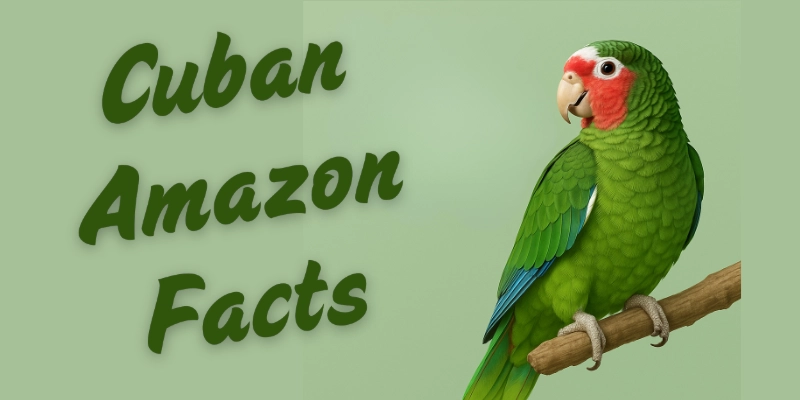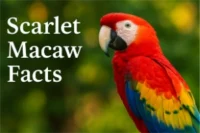Rare Cuban Amazon Facts Revealed
Published: 19 Jun 2025
The Cuban Amazon is a medium‑sized, vibrant green parrot native to Cuba, the Bahamas, and the Cayman Islands. With its rosy-pink throat, white forehead, blue‑tipped wings, and charming chatter, it’s a vivid highlight of the Caribbean skies. In this blog, we’ll explore fascinating Cuban Amazon facts that reveal what makes this parrot so unique and special.
Unfortunately, habitat loss, disasters like hurricanes, and illegal trapping have pushed its status to Near Threatened on the IUCN Red List.
Let’s delve into various aspects of their lives to understand them better.
Categories & Facts
Here are the Cuban Amazon parrot facts by:
1. Physical Appearance & Subspecies
2. Distribution & Habitat
3. Diet & Foraging
4. Behavior & Vocalization
5. Reproduction & Lifespan
6. Conservation & Threats
1. Physical Appearance & Subspecies
Let’s start with how the Cuban Amazon looks and the various subspecies that exist—each with unique traits.
- Roughly 28–33 cm long with a wingspan about 183–204 cm.
- Main body is green; blue primaries; white forehead and eye ring; pinkish face and throat; maroon belly patch.
- Juveniles have darker ear-coverts, less red, and yellow-tinged crowns.
- Five subspecies: Cuban (leucocephala), Bahamian (bahamensis), Cayman (caymanensis), Cayman Brac (hesterna), and western Cuban (palmarum).
- Subspecies differ in intensity of red/blue plumage and size.
2. Distribution & Habitat
Now that you can identify them, here’s where these parrots call home and the kind of environments they prefer.
- Found in Cuba (mainland, Isle of Youth), Bahamas (Abaco, Inagua), Grand Cayman, Cayman Brac.
- Prefers dry forest, pine woodlands, mangroves, palm groves, and farmed areas up to about 1,000 m elevation.
- In Cuba, the strongest populations are in the Zapata and Guanahacabibes peninsulas.
- On Great Abaco, unusual underground nesting in limestone cavities protects them from fires.
- Generally non-migratory but Abaco parrots move seasonally to coastal areas .
3. Diet & Foraging
Like most parrots, the Cuban Amazon has a diverse diet. Here’s what fuels its daily energy.
- Eats fruits, seeds, leaf buds, cones, and cultivated crops like palm fruits and West Indian mahogany seeds.
- Forages in small groups or larger flocks at abundant food spots.
- Diurnal (active in daytime) and highly social.
4. Behavior & Vocalization
Let’s take a look at how these birds behave in the wild and how they communicate with each other.
- Lives in flocks during non-breeding season; forms monogamous pairs when breeding.
- Known for loud shrieks, whistles, screeches, and trumpet-like calls.
- Intelligent and curious—enjoys toys, chewing branches, and mental stimulation.
5. Reproduction & Lifespan
Understanding how the Cuban Amazon breeds and how long it lives gives us more insight into its natural cycle.
- Breeding season runs from March to September.
- Clutch size: 2–4 white eggs; incubated for ~26–28 days.
- Chicks fledge around 8–12 weeks.
- In captivity, they can live 50–60 years.
6. Conservation & Threats
These birds face many challenges today. Here’s why they need our attention more than ever.
- Estimated Cuban population ~10,000; Isle of Youth ~1,100–1,320; Grand Cayman ~3,400; Cayman Brac ~400–500.
- Threats include habitat destruction, hurricanes, and illegal trapping for pet trade.
- Classified as Near Threatened (IUCN) and listed in CITES Appendix I, prohibiting commercial trade.
- Conservation: nest‑box projects, population surveys, and pet amnesty (e.g., Cayman Islands micro‑chipping in 2020) .
- Protected habitats include national parks and ecological reserves, such as Zapata and Guanahacabibes.
Interesting Behaviors & Aviculture Notes
There are also some quirky and important things to know if you ever come across Cuban Amazons in captivity.
- Some male Cuban Amazons can show aggression toward mates and chicks—breeding pairs must be carefully managed in captivity.
- Rare in aviculture until the mid‑1980s; difficult to breed and costly due to aggression and low availability.
- Popular in places like Russia and Florida; several color mutations exist in captivity.
Conclusion
So guys in this article we have discussed Cuban AMazon Facts in detail. The Cuban Amazon is a beautifully colored and sociable parrot, iconic to the Caribbean. While it thrives in vibrant habitats across several islands, it’s under pressure from human-caused threats. Thankfully, active conservation efforts—like protected areas, monitoring, and community initiatives—are in motion. Understanding and caring about this species can help maintain its presence in our world for future generations.

Let’s not wait for another species to vanish like the Cuban Macaw—stay curious, support conservation, and be a voice for the Cuban Amazon while it still sings in the wild.
👉🏻 Read our next article on Cuban Macaw and explore everything about this amazing bird.
References
The following references have been gathered from various reliable online sources to support the information presented above.
1.https://en.wikipedia.org/wiki/Cuban_amazon?utm_source=chatgpt.com
2.https://animaldiversity.org/accounts/Amazona_leucocephala/?utm_source=chatgpt.com
3.https://en.wikipedia.org/wiki/Cuban_amazon?utm_source=chatgpt.com
4.https://animaldiversity.org/accounts/Amazona_leucocephala/?utm_source=chatgpt.com
5.https://parrots.org/encyclopedia/cuban-amazon/?utm_source=chatgpt.com
6.https://www.exmoorzoo.co.uk/animal/cuban-amazon/?utm_source=chatgpt.com
7.https://parrots.org/encyclopedia/cuban-amazon/?utm_source=chatgpt.com
8.https://susanclubb.com/knowledge-center/bird-species-profiles/14-amazons/26-cuban-amazon?utm_source=chatgpt.com
9.https://www.exmoorzoo.co.uk/animal/cuban-amazon/?utm_source=chatgpt.com
10.https://theparrotsocietyuk.org/site/index.php/parrot-information/articles/articles-on-parrot-species/the-cuban-amazon/?utm_source=chatgpt.com
FAQs About the Cuban Amazon
Still curious? Here are the most frequently asked questions people have about Cuban Amazons and their lifestyle.
The Cuban Amazon is a medium-sized, colorful parrot native to Cuba and nearby islands. It’s known for its green body, pink throat, white face, and playful personality. It’s a social and intelligent bird, often seen in flocks.
They are found in Cuba, the Isle of Youth, parts of the Bahamas (e.g., Abaco), Grand Cayman, and Cayman Brace. These birds live in forests, pine woods, and coastal mangroves. Some even nest underground in the Bahamas!
Their diet includes fruits, seeds, berries, nuts, and flowers. They also feed on crops like maize and palm fruits. They forage in groups and are active during the day.
In the wild, they can live 20–30 years, depending on conditions. In captivity, with proper care, they may live up to 50 or even 60 years. Their lifespan increases with a healthy diet and mental stimulation.
They are currently classified as Near Threatened by the IUCN due to habitat loss and illegal pet trade. Populations are decreasing in some regions. Conservation efforts are helping, but continued protection is essential.
They are intelligent, social, and entertaining birds but need lots of attention and space. They can be noisy and require mental stimulation and social interaction. Not ideal for beginners, but rewarding for experienced parrot owners.
They use loud calls, whistles, and screeches to communicate with each other. During flight or alarm, they become especially vocal. In captivity, they may learn to mimic human words or sounds.
The breeding season is from March to September, depending on the region. Females usually lay 2–4 eggs in tree cavities or limestone holes. Both parents care for the chicks until they fledge.
Main threats include habitat destruction, hurricanes, and illegal trapping for the pet trade. Nesting sites are also disturbed by tourism and farming. Conservation actions are crucial for their survival.
Support local conservation groups, report illegal wildlife trade, and avoid buying wild-caught birds. Share awareness about the species and its declining population. Eco-tourism and community education also play a big role.

- Be Respectful
- Stay Relevant
- Stay Positive
- True Feedback
- Encourage Discussion
- Avoid Spamming
- No Fake News
- Don't Copy-Paste
- No Personal Attacks

- Be Respectful
- Stay Relevant
- Stay Positive
- True Feedback
- Encourage Discussion
- Avoid Spamming
- No Fake News
- Don't Copy-Paste
- No Personal Attacks





